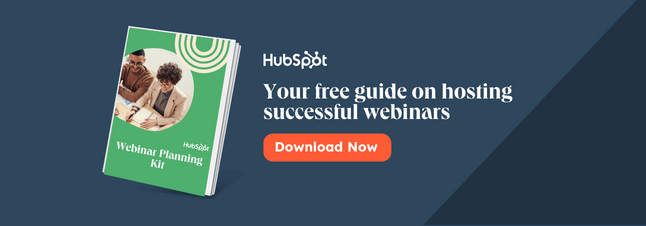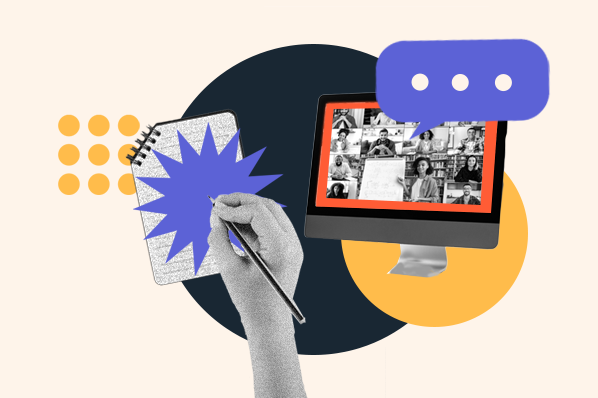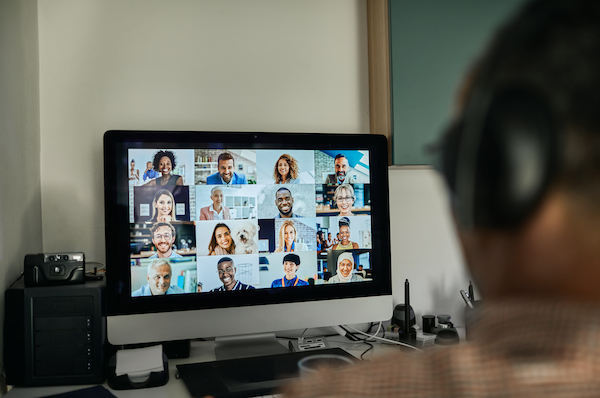What if I told you that you can host this event and do so live with all of these people who are critical to your business’s success included?
You just need to host your event via webinar.
What is a webinar?
A webinar is an online video presentation, seminar, lecture, or workshop delivered via the internet. Typically, webinars are shared live, or in real-time, but they can also be recorded before being shared with audience members.
Whether or not a webinar is live, it must include an interactive element that allows viewers to participate, ask questions, make comments, or collaborate with the presenters and/ or hosts.
Let's review the typical anatomy of a webinar.
Elements of a Webinar
- Main event
- Host and presenter(s)
- Attendees
- Desktop computer or laptop with a camera and microphone
- Presentation (usually in the form of slides)
- Interactive element for attendees to participate in (e.g. survey, poll, or discussion)
- Webinar software (we’ll review some of these options shortly)
What is the purpose of a webinar?
Webinars provide businesses with a way to host a digital, interactive event for members of their target audience and customers, no matter their location.
Webinars can be used to boost conversions, improve brand awareness, increase revenue, and establish yourself as an expert in your field.
Webinar Benefits
Webinars are an effective way of reaching many members of your target audience at once through an engaging event that doesn’t require anyone to be in the same location.
Let's dive into some of these benefits in greater detail.
1. Personalize your content and event.
Webinars are an easy way to create unique and personalized content for your brand. You can include a variety of presentation features in your webinar to enhance the experience for viewers and audience members. These include drawing tools, interactive activities, slides, surveys, chat, and more.
2. Stick to your budget.
Webinars are budget-friendly. Think about it this way: If you’re hosting an in-person event for your target audience and customers, you’ll likely have to rent out space, order food and drinks, purchase presentation equipment, and more.
If you have this event catered, you might need to organize wait staff and pay for clean up, too. Meanwhile, webinars are low cost and can even be hosted for free.
3. Educate prospects and customers on your product of service.
Webinars are a simple way to educate your audience. You might choose to explain the benefits of your product or service, review its capabilities and features, or even hone in on how it resolves the challenges of your buyer personas and current customers.
4. Demonstrate your product or service.
In addition to educating your webinar attendees about your product or service, you can also provide an instructional demonstration on how your attendees can use or implement your product or service.
5. Establish yourself as a thought-leader in the industry.
By hosting webinars, you can establish yourself as a thought-leader in your industry. If you're regularly hosting educational webinars through which attendees are gaining actionable tips and learning from you and your guests, you'll be more likely to gain more authority in your industry.
6. Improve your brand awareness.
And speaking of establishing yourself in your industry, webinars are just another way of improving your brand awareness.
You're able to target your target audience and personas through this channel and encourage audience members to share your webinar, or invitation to your webinar, with their peers and coworkers.
7. Boost conversions and revenue.
You can use your webinar as a source of conversions and revenue. By establishing yourself as a thought-leaders, prospects will be more inclined to trust you and therefore, your product or service. Additionally, as you promote and share your webinar, your increased brand awareness will naturally lead to more conversions, too.
Another benefit to hosting webinars is the fact that you can choose the format that is most complementary to your goals and whatever it is you're trying to achieve. Here are some of those formats to give you a better understanding of what I mean.
1. Industry Expert Panel
Invite an industry expert — internal or external — to discuss their niche, or whatever it is they're known for. You'll attract your audience and the experts' audiences, too.
2. Interview
Host an interview with an internal or external thought-leader, a member of your team, a current and loyal customer, or even someone outside of your industry.
Think about the various topics your audience members want to hear about, and then find the right interviewer and interviewee for the discussion.
3. Product/ Service Pitch or Demo
Provide your audience with a product or service pitch or demonstration to clearly show people the benefits and applications of whatever it is you sell.
4. Q&A
Host a question and answer webinar between your brand and the audience. You might invite a member of your leadership board to host the Q&A and have employees (sales reps, service reps, marketers, product managers, etc.) sit in to answer questions that audience members have.
5. How To
Offer audience members an instructional how-to webinar — teach them how they can achieve a goal that many of your current customers have. Or, look to your buyer personas and review their challenges — choose one of those roadblocks and offer a how to that describes effective resolution.
6. Casual Chat
Whether it's with a member of your team or an external thought-leader, have a casual chat during your webinar. This way, audience members can tune in, sit back, and enjoy wherever the conversation naturally goes — and they can ask questions to spark new directions for that discussion.
7. Case Study
Look at your past case studies — which one is most compelling or has the most views on your website or social platform?
Invite that client to come onto your webinar to talk about how your product or service resolved their challenges and why they're advocates for your brand. You may also allow time for Q&A at the end if you and your client choose to — this way, audience members can ask your loyal client any questions they may have.
Now that you have an idea about possible webinar formats, let's dive into how a webinar actually works.
The webinar should educate, demonstrate, instruct, or explain something to your attendees. Results of the webinar may include: your business being recognized as an industry expert, improving brand awareness, or boosting conversions and sales.Whether or not your webinar is live, it should always be recorded. This way, you’ll have the recording for your files, future reference, and your website since webinars are often an excellent source of evergreen content.
As you host more events, share your evergreen webinar content via a resource library — similar to HubSpot’s Free Webinars library — on your website. Your site visitors, loyal customers, and team members will be able to easily reference your webinars in a central location.
A major part of understanding how a webinar works is also understanding associated best practices.
Webinar Best Practices
Let’s cover some webinar tips and best practices so your event is sure to be a success.
- Choose an intriguing, personable, and qualified presenter(s) to get your audience excited about attending and to hold their attention throughout the event.
- Determine whether the webinar is going to be live or pre-recorded based on factors such as topic, presenters, industry, and audience.
- Invite members of your target audience and your buyer personas to register (this will ensure your webinar content is shared with people it’ll be relevant and valuable to).
- Clearly set and share the event’s date, time, and other logistics so attendees can log on, view, and participate without experiencing any roadblocks.
- Stick to one major topic per webinar to avoid confusion and keep attendees engaged.
- Establish a format for the webinar (e.g. panel, FAQ, single or multi-presenter, demonstration, interview, or discussion).
- Complete a dry run (or several) before going live or recording the webinar.
- Find the right webinar software for your specific business needs.
- Allow ample time for attendee participation.
- Record and save your webinar —whether or not it’s shared live — to your webinar library.
Now, how do you actually record your webinar? Let’s review the answer to that question next.
No matter how you decide to format your webinar, simply click Record when your event begins and Stop Recording when your event ends (or similar commands).
Speaking of webinar software, let’s look at some of your options. Your software is how you’ll host the webinar, share it with attendees, analyze its performance, and more.
Webinar Software
Webinar software offers features that streamline all aspects of hosting your event. There are many webinar software options available with a range of features and pricing options. Here are seven options to get you started.
1. GoToWebinar
GoToWebinar simplifies your event planning, promotion, engagement, and reporting. The software provides several webinar templates, custom registration, different presenter webcams, interactive surveys and polls, source tracking, and webinar analytics.
Note: GoToWebinar integrates with your HubSpot CRM.
Cost: GoToWebinar offers three plans starting at $89 per month.
2. Demio
Demio is a webinar platform built for engagement. Demio is a great option for Marketing, Sales, and Customer Success teams because it is a simple, no-download webinar experience, makes engaging attendees easy and effective, and provides the analytics tools you need to generate better business results. Whether you want to host a live, on-demand, hybrid, or automated webinar, Demio is a great option.
Note: Demio integrates with your Hubspot CRM.
Cost: Demio offers a free trial (no credit card required) and three plans starting at $49 per month.
3. ClickMeeting Webinars
ClickMeeting makes hosting and sharing your live or pre-recorded events easy no matter your webinar format (e.g. conference, group discussion, Q&A, or product demos). The software includes a feature to live stream your event via Facebook or Youtube to expand your audience.
Note: ClickMeeting Webinars integrates with your HubSpot CRM.
Cost: ClickMeeting is free for your first 30 days, and then you can choose to upgrade to one of their three paid options, which start at $25 per month.
4. Zoom
Depending on the Zoom plan you choose, you can share your webinar with over 10,000 people at once. The software offers HD video and audio, live broadcasting features, reporting, and analytics. There are also various participant engagement tools such as chat, attendee-raise-hand, and polling to ensure your webinar is interactive.
Note: Zoom integrates with your HubSpot CRM.
Cost: Zoom has a freemium option in which you can host a discussion-based webinar event where everyone can see and interact with each other. If you choose one of their paid options, which start at $14.99 per month, you can host your webinar in any format (e.g. lecture-based, single presenter, or multi-presenter).
5. Airmeet
Webinars with Airmeet empower users to deliver a premium and immersive experience to their attendees. The platform helps manage webinar workflows, expand audience reach, improve engagement, streamline demand generation efforts, and increase ROI. It enables you to host a variety of webinars, including live, streaming, and pre-recorded sessions, catering to both small-scale and large-scale audiences.With its 360-degree features such as branding, engagement, real-time analytics, and customer support, Airmeet ensures a seamless and memorable webinar experience for organizers, speakers, and attendees.
Note: Airmeet integrates with your HubSpot CRM.
Cost: Airmeet offers a 10-day free trial, enabling users to explore its entire suite. The platform offers three pricing plans and personalized quotes tailored to user demand and requirements. The plans are unlimited in nature and based on the total number of attendees at an event rather than the total number of registrants.
6. EasyWebinar
EasyWebinar is a great option for anyone new to the world of webinars because the software has users work through a five-step campaign process to ensure event success. It includes customer tracking tools to learn more about who your attendees are and why your content is relevant to them. EasyWebinar integrates with WordPress and YouTube so you can expand your reach among your target audience and current customers.
Cost: There are three tiers of EasyWebinar which start at $78 per month.
7. eWebinar
eWebinar is your best option for creating and hosting automated webinars (also known as evergreen webinars) since that is 100% the focus of their software.
Their setup process is simple and starts with uploading a video of your pre-recorded presentation. From there, you can program polls, questions, tips, and other interactions to appear at key moments in your webinar to make the experience interactive. Their unique and flexible chat system lets you chat live with attendees or respond to messages later through email at your convenience.
Cost: eWebinar offers a free 14-day trial and has four pricing levels based on the number of published webinars you have, though each webinar can have unlimited sessions and attendees.
How to Host a Webinar for Free
To host a webinar — and do so for free — you’ll need to combine all of the elements we’ve reviewed above. You might think about the following five steps to hosting a webinar for free as your webinar strategy.
1. Choose free webinar software.
The first step in hosting your webinar requires you to choose software that suits your specific needs. We reviewed some popular examples above, but for more options that are easier on your budget, take a look at these free webinar tools.
2. Invite your target audience to register for and attend your event.
It’s time to invite people to register for and attend your webinar. When you invite these members of your contact list and network to register, likely via email, clearly indicate the date and time of your event. This way they’ll know if they’re available or if they need to make time on their calendars to attend.
3. Send a confirmation email to anyone who’s registered to attend.
Next, confirm webinar registration is complete for each attendee who has signed up. You might do this by sending registrants to a new landing page with their confirmation details. Another option is to send a follow-up email to attendees shortly after they complete registration.
Either way, include details in your confirmation message about the equipment needed to participate in your webinar such as a laptop with stable Wi-Fi, speakers, a microphone, and a camera. You can also provide information about your presenters or the interactive element of the webinar to get attendees excited.
4. Provide a link for attendees to “Join” if the webinar is live or “Watch” if it’s pre-recorded.
One of the most important things you do pre-webinar is provide clear directions on how your attendees will join or watch the event. For example, you may include a link to Join or Watch your webinar on the confirmation landing page or in the follow-up email we mentioned above.
5. Set expectations for webinar participation.
Again, webinars must be interactive in some way. Set these expectations early on, and have your presenters reiterate them at the beginning of the event, so everyone is on the same page. If your event is live, facilitate participation and discussion throughout the event or set aside time for discussion and Q&A at the end.
If your event is pre-recorded, set a window of time after the webinar has been shared for attendees to send in questions. Then, presenters can either record or type their responses and send them back to the corresponding attendee.
6. Host the webinar, and follow up with attendees afterward.
It’s time to host your event! Explain the agenda to attendees at the beginning of the webinar so they know what to expect. (This is also a great time to reiterate those expectations for participation we mentioned above.)
Don’t forget to review all other details, like follow-up communication, any further inquiries, future webinars you’re hosting, and how attendees can learn more about your business. Feel free to email this information to your attendee contact list post-webinar so they can review it in greater detail later on.
Reach Your Target Audience With Webinars
Webinars have the power to propel you towards becoming a thought-leader and expert in your industry. They can also help you improve brand awareness, reach your target audience and buyer personas, and boost conversions. Determine which webinar software is right for your business, keep the best practices we reviewed in mind, and begin hosting your online events.
Editor's note: This post was originally published in October, 2019 and has been updated for comprehensiveness.
Webinars











![How to Write a Webinar Script [+ Template]](https://53.fs1.hubspotusercontent-na1.net/hubfs/53/181_Write-a-Webinar-Script.png)